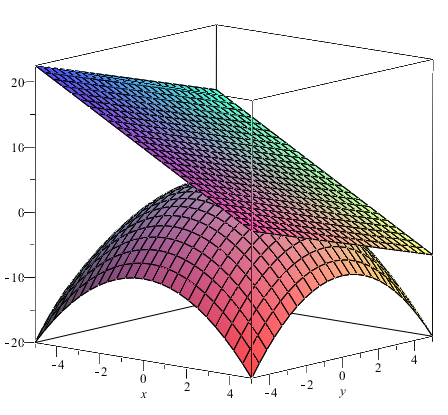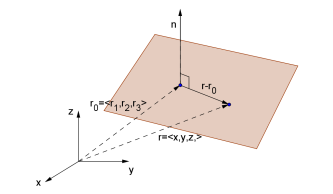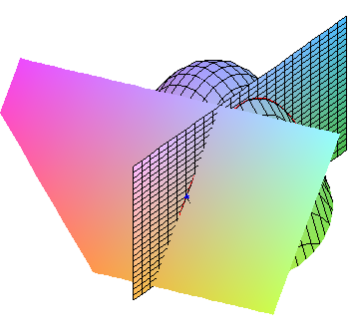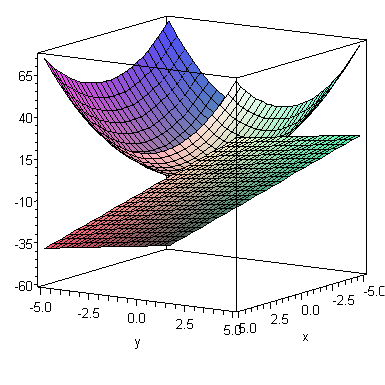Section 5.1 Tangent Planes
Recall that the graph associated with the function \(z=f(x,y)\) is a surface in \(\mathbb{R}^3\) (that passes the vertical line test). Wherever this surface does not have any discontinuities or cusp-like points it will have a tangent plane. Like the tangent line to the graph of a function of one variable, the tangent plane to the function \(z=f(x,y)\) at the point \((x_0,y_0)\) is the plane that “just touches” the surface at the point \((x_0,y_0,z_0)\text{.}\)
Example 5.1.1.
For the function \(f(x,y) = 5-\dfrac{x^2+y^2}{2}\) the graph below shows the graph of the function and it's tangent plane at the point \((x,y) = (2,1)\text{.}\)

To find the equation of the plane tangent to the function \(z=f(x,y)\) at the point \((x_0,y_0,z_0)\text{,}\) firstly recall that the equation of a plane in Cartesian form is given by
or in normal form, as illustrated in Figure 5.1.3, by
where \(\mathbf{n} = \langle a,b,c \rangle\) is a normal vector to the plane, \(\mathbf{r}_0\) is the position vector of a point on the plane and \(\mathbf{r} = \langle x,y,z \rangle\text{.}\)

Example 5.1.4.
Find the equation of the tangent plane to the function \(f(x,y) = 5-\dfrac{x^2+y^2}{2}\) at \((x,y) = (2,1)\text{.}\)
\(2x+y+z=\dfrac{15}{2}\)
Now, we know that the partial derivative \(f_x(2,1)\) gives the slope of the tangent at \(x=2\text{,}\) to the curve of intersection of the surface associated with \(f\) and the plane \(y=1\text{.}\)

Since this tangent line lies in the plane tangent to \(f\) at \((x,y) = (2,1)\) the vector
will be a vector that is parallel to the tangent plane, (or lies in the tangent plane if we place it’s tail at the point \((2,1,\frac{5}{2})\)). Similarly, the vector
will be another vector parallel to the tangent plane. Since these two non-parallel vectors are parallel to the tangent plane, their vector product will give a vector normal to the tangent plane, i.e.
Thus, using equation (5.1.1), the equation of the plane tangent to \(f(x,y) = 5 - \dfrac{x^2+y^2}{2}\) at \((x,y) = (2,1)\) is
which simplifies to
In general, to find the equation of the plane tangent to the function \(f(x,y)\) at the point \((x_0,y_0)\text{,}\) note that the vectors
lie in the tangent plane and hence a normal to the plane is
Since the point \((x_0,y_0,z_0)\) lies on the plane, using equation (5.1.1), the equation of the tangent plane is
On expanding and rearranging this we get the following result.
Theorem 5.1.6.
The equation of the plane tangent to the function \(f(x,y)\) at the point \((x_0,y_0,z_0)\) is
where \(z_0 = f(x_0,y_0)\text{.}\)
Example 5.1.7.
Find the equation of the plane tangent to \(z = x^2+2y^2\) at the point \((x,y)=(1,2)\text{.}\)

\(2x+8y-z-9=0\)
Firstly, note that when \((x,y)=(1,2)\text{,}\) \(z=9\text{.}\) Now
and
Thus the equation of the tangent plane is
which simplifies to
Example 5.1.9.
Find the equation of the line normal to the graph of the function \(z=x^2+2y^2\) at the point \((x,y) = (1,2)\text{.}\)
\(\mathbf{r} = \langle 1, 2, 9 \rangle + t \langle -2, -8, 1 \rangle\)
Recall that the vector equation of a line in \(\mathbb{R}^3\) is
where \(\mathbf{r} = \langle x, y, z \rangle\) is the position vector of a general point, \(\mathbf{r}_0\) is the position vector of a point that lies on the line and \(d\) is a direction vector for the line (i.e. a vector that is parallel to the line).
We know that a vector normal to the surface \(z=f(x,y)\) at the point \((x_0,y_0,z_0)\) is given by
For the function \(z=x^2+2y^2\text{,}\) \(z_x=2x\) and \(z_y=4y\text{.}\) Thus a direction vector for the line normal to \(z=x^2+2y^2\) at the point \((x,y)=(1,2)\) will be
Since the normal line passes through the point \((1,2,9)\) its equation is
Exercises Example Tasks
1.
Find the equation of the tangent plane to \(z=x^2-5xy+2y^2\) at the point \((x,y)=(-1,-2)\text{.}\)
2.
Find the equation of the tangent plane and normal line to \(z = \sqrt{x+y} \sin (xy)\) at the point \((x,y)=(0,1)\text{.}\)
3.
Show that every line that is normal to the sphere \(x^2+y^2+z^2 = 1\) passes through the origin.